
Kingfishers and Woodpeckers
Kingfishers are fish-eating birds while most woodpeckers prefer insects.

Types of Kingfishers and Woodpeckers
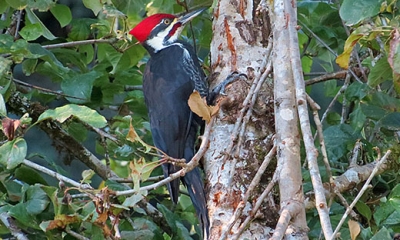
The Pileated woodpecker was the model for the cartoon character, Woody Woodpecker. It is a large black-and-white bird with a bold red feathered crest and distinctive call. You may hear its powerful drumming before you see it.
In Oregon, its habitat includes older forests in the Blue Mountains, East and West Cascades, Klamath Mountains, Willamette Valley and Coast Range ecoregions. They prefer mature forests and younger forests with large snags and logs, requiring large diameter snags for nesting and foraging.
Pileated woodpeckers are an Oregon Conservation Strategy Species in the Blue Mountains ecoregion.
Hear the call and the drumming of the Pileated woodpecker
Photo by Jo Leach

This majestically crested bird is often heard before being seen due to its conspicuous harsh rattling call.
Kingfishers are most frequently associated with lake and pond shorelines and islands, as well as coastal dunes with ponds and widely scattered shrubs and trees. They hunt from a vantage point above water such as an overhead branch, telephone wires along shore lines or pilings of piers.
This is a common permanent resident throughout most of the state except in the north Lake and east Deschutes counties where open water is generally absent
Hear the call of the belted kingfisher
Photo from ODFW

The Lewis's woodpecker was named for Meriwether Lewis, who first described the species in 1805. This medium-sizesd vaguely crow-like woodpecker relies on flycatching during the spring and summer and store mast in the fall and winter.
Formerly widespread in Oregon, it is currently common year-round only in the white oak-ponderosa pine belt east of Mt. Hood. It also breeds in low numbers in open habitat along east Oregon river and stream valleys.
The Lewis's woodpecker is an Oregon Conservation Strategy Species in these ecoregions: Blue Mountains, Columbia Plateau, East Cascades, Klamath Mountains, West Cascades.
Hear the call of the Lewis's woodpecker
Photo by Dave Herr
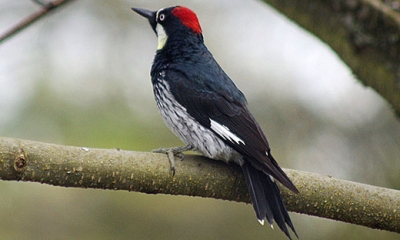
Spirited vocalizations make this handsome clown-faced woodpecker one of the more conspicuous residents of much of Oregon's oak woodland. It is unique among Oregon woodpeckers with its habits of communal living and acorn storage.
It is fairly common in the Rogue Valley and adjacent hills and locally common in the Klamath River Canyon in southwest Klamath county and the southern part of the Willamette Valley.
Acorn woodpeckers are Oregon Conservation Strategy Species in both the Klamath Mountains and Willamette Valley ecoregions. Loss of oak woodlands poses a major threat to this bird.
Hear the call of the Acorn woodpecker
Photo by Martyne Reesman, ODFW

Male and female Williamson's sapsuckers look so different that until 1873, ornithologists thought they represented two distinct species. The mostly black male has a bright yellow belly and red chin. The female is pale brown with barred back and wings and dull yellow belly.
It is a summer resident of forests in the Blue Mountains, on the east slope of the Cascades and east to Warner Mountains in the south. It breeds in mid - to high-elevation mature or old-growth conifer forests with fairly open canopy cover, and large dead trees suitable for nest cavities.
Hear the call of the Williamson's sapsucker
Photo by Ken Schneider, Flickr
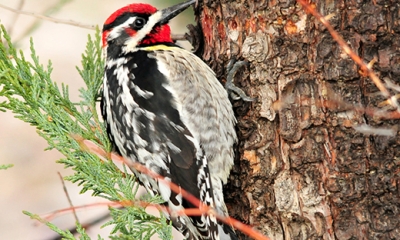
Lines of neatly drilled holes in even the smallest strand of aspen east of the Cascade summit are likely the work of the Red-naped sapsucker.
The Red-naped sapsucker is a common summer resident throughout forested mountains east of the crest of the Cascades and a spring and fall migrant through the same mountains and lower elevations, preferring areas with trees.
Hear the call of the Red-naped sapsucker
Photo by Tom Koerner, USFWS
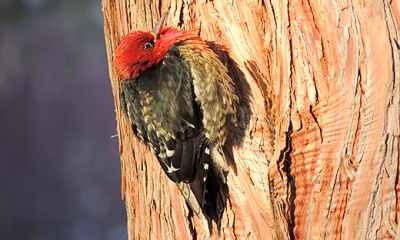
The only sapsucker regularly found in western Oregon, the Red-breasted sapsucker, with its raspberry-red head and breast, is unmistakable. It is found in moist coniferous coastal forest and mixed deciduous-coniferous coastal forest west of the Cascade crest, and in aspen-ponderosa pine forests east of the Cascades. Nest cavities are typically in large snags or live trees with decayed interiors.
It is a fairly common breeder in the northern part of the state from the coast to the Cascades and south to the southern Cascades.
Hear the call of the Red-breasted sapsucker
Photo by Darla Marie Prater

This active and often unwary woodpecker, the smallest in North America, is generally the most often seen black and white woodpecker in human-settled areas.
A preference is shown for decayed wood for nesting, though sound wood is also utilized. Nest sites are usually 10 to 12 feet off of the ground.
It is found mostly at low to moderate elevations in deciduous and mixed deciduous-coniferous forests throughout much of the state, and less often in coniferous forests.
Hear the call of the Downy woodpecker
Photo by ©Keith Kohl, ODFW
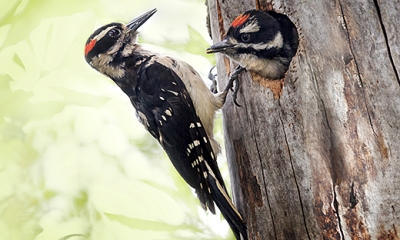
This medium-sized woodpecker may be found in virtually any forested area in Oregon. It is found primarily in mixed-conifer and ponderosa pine forests, as well as adjacent deciduous stands, especially during the breeding season.
Hairy woodpeckers feed on beetles, ants and other insects, spiders, miscellaneous plant matter, elderberry corn and mast (mostly acorns), and a few seeds. They are regular visitors to suet feeders and have been observed drinking from hummingbird feeders in central Oregon.
It is a resident in forests throughout Oregon with the exception of juniper. Common throughout most of this range, but uncommon to fairly common along the coast and in western interior valleys. It is most common in burns or areas with trees that are dead from or infested with mountain pine beetles.
Hear the call of the Hairy woodpecker
Photo by Kelle Herrick
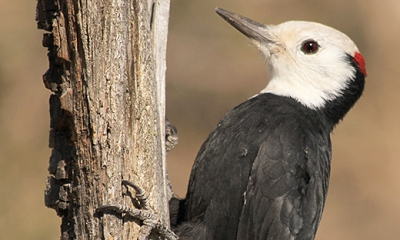
The White-headed woodpecker is the only woodpecker that relies heavily on the seeds of ponderosa pine for food. It occurs mainly in open ponderosa pine or mixed conifer forests dominated by ponderosa pine. They usually excavate nest cavities in snags but may use stumps, leaning logs and dead tops of live trees.
It is an uncommon permanent resident in forests of the Ochoco, Blue, and Wallowa mountains and the east side of the Cascades, but suitable habitat is restricted.
The White-headed woodpecker is an Oregon Conservation Strategy Species in the Blue Mountains, East Cascades, and Klamath Mountains ecoregions.
Hear the call of the White-headed woodpecker
Photo by Simon Wray, ODFW
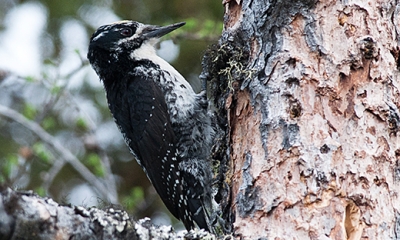
In Oregon, the American three-toed woodpecker tends to use higher-elevation forests; however, forest type may not be as important to this species as the presence of bark beetles.
Nests are often fairly low; nest trees are often smaller in diameter than those used by other cavity nesters. Habitat requirements may include trees with heartrot for nesting and high densities of bark or wood-boring beetles.
It is rare and local, particularly near and west of the Cascade summit, often near high-elevation lakes or beetle outbreaks. American three-toed woodpeckers are Oregon Conservation Strategy Species in the Blue Mountains and East Cascades ecoregions.
Hear the call of the American three-toed woodpecker
Photo by Peter Wilton
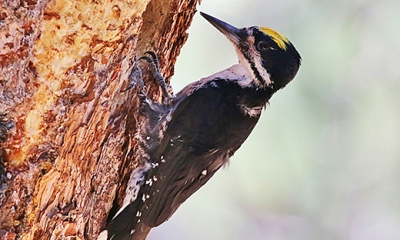
The Black-backed woodpecker can often be found in the open expanses of a recent forest fire or the twiggy closets of a bark beetle outbreak. It may be heard before seen, with its accelerating drum ringing from a prominent snag or its snarling call.
Its nest is often low in a tree; both living and dead trees are used, but may require heartrot for excavation of nest cavities. Nest trees are often smaller in diameter than those used by other cavity nesters.
It is a rare to locally common resident near the summit and on nearby plateaus and ridges on the west side of the Cascades and is more widespread on the east slope.
The Black-backed woodpecker is an Oregon Conservation Strategy Species in the Blue Mountains and East Cascades ecoregions.
Hear the call of the Black-backed woodpecker
Photo by Tom Benson, Flickr
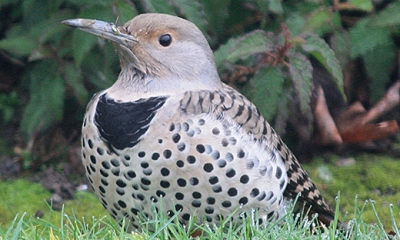
The Northern flicker is larger than most woodpeckers in Oregon. It is primarily lighter shades of brown and gray with black markings: spotted underparts, barred back, and a broad necklace. Its wing linings and undertail range from salmon to yellow, and the rump is white. Males have a red or black mustache.
Northern flickers may be encountered in almost any terrestrial habitat, but are generally most abundant in open forests and forest edges adjacent to open country. They venture into nearby habitats, including towns and farms but typically avoid dense forests. It is a common resident throughout Oregon.
Hear the call of the Northern flicker
Photo by Kathy Munsel, ODFW

